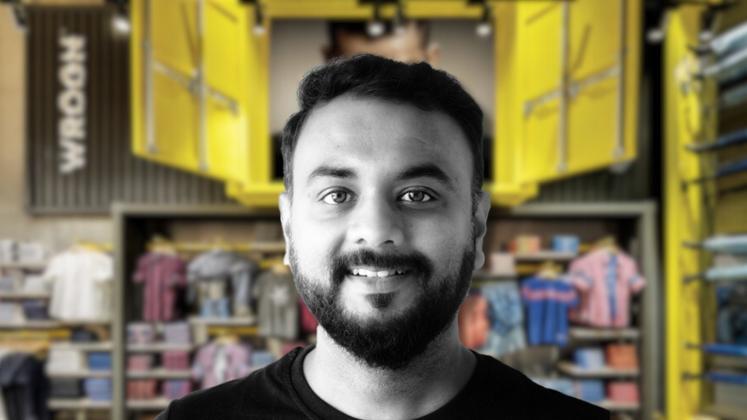Fashion is redefining itself and evolving from real to reel. WROGN – a fashion brand in India – has embraced this digital dynamism, ensuring a seamless transition between the virtual and real while maintaining the valued human connection.
In a revealing session of The AR Interview with Nishant Poddar, CMO and Head of Retail Experience at WROGN, we explore the brand’s innovative strategies at the intersection of online and offline realms. Read how WROGN, as an omnichannel brand, utilises technology to create a seamless shopping experience in order to stay ahead in the game.
AR: How has the retail landscape evolved for the consumers over the years?
Nishant: The advancements began with the internet weaving a web of connections, with it developed on e-commerce. It redefined shopping, bringing the markets and products right to our living rooms.
Then there was a seismic shift in how we handle money, thanks to digital payment methods that became a lifeline post-demonetisation. Our wallets went digital, and with them, so did our freedom to transact in new and effortless ways.
| When someone browses our website but stops short of buying, we don’t just wish them well and wave goodbye. Instead, we reach out with a friendly nudge, maybe in the form of a special offer or a reminder that guides them back, be it through online or through our doors. |
Meanwhile, social media platforms transformed from casual hangouts into vibrant retail hubs. They’re the new streets where trends come alive, products find their spotlight and purchases are just a post away, often shepherded by influencers who know just how to strike a chord with the younger crowd.
The boundary between the physical store and the online shop has faded. The old guard of retail is now infused with digital dynamism, offering us a seamless transition between the virtual and the real, without losing the human connection we value.
And behind the scenes, the logistics and supply chain machinery have become quicker and more intelligent, ensuring that our purchases make their way to us swiftly and without fuss.
AR: How does WROGN use ‘data’ to influence its inventory and garment design process?
Nishant: WROGN utilises data largely to understand the Customer Preferences in order to decipher the trends. This is largely led by analysing sales data, social media engagement and online browsing behaviour. WROGN can identify which styles, colours and types of garments are trending or are more popular with its target audience.
We also go through the feedback, ratings and reviews as received from our customers which helps us understand better what customers like and dislike about our products. This information guides us to take conscious calls for design to delivery thereby delivering a better customer experience.
Details including the rate at which items are sold, peak buying times and the popularity of items in different regions help in better planning and forecasting. These impact the inventory turnover directly where the data available can be put to use to plan on how quickly items can be sold and restocked to help optimise inventory levels, ensuring that best sellers are readily available while minimising excess stock that requires discounting. This is done for seasonal and regional alignments of the inventories too.
We also use data for competitive analysis which helps us track the trends, requirements of the customers on the basis of style, quality and price.
The available data can also give a sneak peek into our customers’ minds, revealing patterns and preferences we might have missed if we only looked at online or offline data alone. When someone browses our website but stops short of buying, we don’t just wish them well and wave goodbye. Instead, we reach out with a friendly nudge, maybe in the form of a special offer or a reminder that guides them back be it through online or through our doors.
Simply putting, data allows WROGN to make informed decisions that align our inventory and design processes with consumer demand, market trends and operational efficiencies, ultimately aiming to reduce waste, increase sales and improve customer satisfaction.
AR: How is WROGN leveraging AI for personalised product pricing and what impact does it have on your conversion rates and sales?
Nishant: AI can be deployed for customer data analysis, including past purchases, browsing history, engagement and price sensitivity, to determine the optimal price point for each customer or segment.
We are using algorithms to adjust price offers in real-time based on supply and demand, competitor pricing and other market factors to generate dynamic pricing models alongside forecasting using predictive analytics for buying trends and price elasticity.
| We will also enhance the use of Artificial Intelligence to provide highly personalised shopping experiences by projecting trends and preferred product recommendations. AI will also help to minimise overproduction and enhance the endless aisle. |
Tailored discounts and promotions to individual customers are offered based on their likelihood to purchase at certain price points, maximising the chance of conversion.
The impact has been clear with increased conversion rates, whereby offering the right price to the right customer at the right time leads to enhanced customer loyalty, optimised inventory.
AR: What initiatives has WROGN taken to personalise the shopping journey for customers, both in online channels and physical stores?
Nishant: We believe that we can provide our customers a better experience only if we understand them. We are leveraging some actions to continue engaging with our customers. We are chalking out a customer funnel and drafting detailed customer profile basis their shopping history, preferences and behaviour that allows us to create personalised recommendation using these data points.
Gradual usage of AI and machine learning is helping us to interpret datapoints and provide personalised product offerings both on the website and via email marketing campaigns.
| WROGN utilises data largely to understand the Customer Preferences in order to decipher the trends. This is largely led by analysing sales data, social media engagement and online browsing behaviour. WROGN can identify which styles, colours and types of garments are trending or are more popular with its target audience. |
Omnichannel integration ensures that the customer experience is seamless across channels such as the ability to check online inventory in real-time or return online purchases in physical stores. We have also implemented In-Store Personal Shoppers and Stylists, offering their services in physical stores to provide a more personalised shopping experience.
AR: Looking ahead, could you share insights into WROGN’s future plans for further digitalisation and technological innovation within its retail operations?
Nishant: We are looking to delve into business with some advanced technologies that we foresee as a big opportunity to improve our retail operations. Advanced Data Analytics gains top spot here as using these tools for a better understanding of our customer preferences and market trends will lead us to more informed decision-making. We will also enhance the use of Artificial Intelligence to provide highly personalised shopping experiences by projecting trends and preferred product recommendations. AI will also help to minimise overproduction and enhance the endless aisle.
Deepening omnichannel capabilities is also in the pipeline so that customers have a seamless experience whether they are shopping online, on a mobile device, or in a physical store. Interestingly, we are adopting technologies such as virtual fitting solutions to reduce returns. Last but not the least, we will be using Customer Journey Analytics as these tools keep a tab and track the end-to-end customer journey across all retail points of sale for a better understanding and improvising and enhancing the customer experience.







